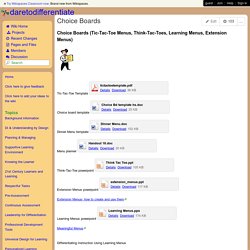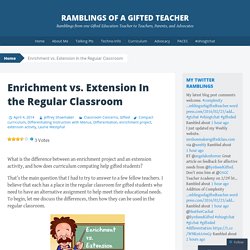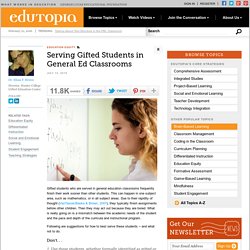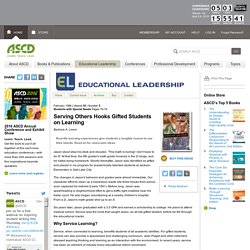

Choice boards packet. Learning Menus - Eight Easy Ideas for Educating Gifted Students. Use Activity Menus to Differentiate & Maximize Student Engagement. Every classroom has a wide range of student abilities – even if your class is already ability grouped.

You will likely have those that finish far before the rest, and those that finish last every time. How do you combat behavior issues that may occur with this “downtime”? Daretodifferentiate - Choice Boards. Tic-Tac-Toe Template Choice board template Dinner Menu template Menu planner Think-Tac-Toe powerpoint Extension Menus powerpoint Extension Menus- how to create and use them Learning Menus powerpoint Grade 7 / Social Studies / Differentiation Please enable Javascript to watch this video.

8 (Mrs. Defino, Math) / Choice Board of the Month. ChoiceBoards. Social Studies Choice Boards. Extension Menus for Gifted Lesson Plans. Photo by kb35 Sick of wrestling with Microsoft Word to create extension menus?

I used The Differentiator to create an Extension Menu generator called Extend A Menu. Hopefully you’ll find it useful. Tips for Teachers: Successful strategies for teaching gifted learners. Davidson Institute for Talent Development 2003 This article by the Davidson Institute for Talent Development offers a list of tips for teachers.

W&M School of Education - Resources. State and National Gifted Policy/Programs Jacob K.

Javits Gifted and Talented Students Education Program The major emphasis of the program is on serving students traditionally under represented in gifted and talented programs, particularly economically disadvantaged, limited English proficient, and disabled students, to help reduce the serious gap in achievement among certain groups of students at the highest levels of achievement. GT_Teacher_Toolkit. Gifted Students: What Motivates Them. Robert Iseminger. RTI Gifted Talented. Tagt challenge strats. Differentiating for Gifted Learners. Teaching Young Gifted Children in the Regular Classroom. ERIC Digest.
Teaching Young Gifted Children in the Regular Classroom.

ERIC Digest. by Smutny, Joan Franklin Recognizing and nurturing giftedness in young children presents an important challenge to educators. Schools need to respond to their educational needs before their abilities diminish or become less recognizable to those who can do something about them. Giftedness in young children refers primarily to "precocity," a rapid rate of development in one or more realms. But giftedness is more than developing skills faster or going through the developmental milestones earlier. Schools have often shied away from early intervention precisely because of the challenge of identification, and because initial assessments are often minimal estimations of a child's actual talent. Gifted Behaviors. . * express curiosity about many things * ask thoughtful questions * have extensive vocabularies and use complex sentence structure. Enrichment vs. Extension In the Regular Classroom.
What is the difference between an enrichment project and an extension activity, and how does curriculum compating help gifted students?

That’s the main question that I had to try to answer to a few fellow teachers. I believe that each has a place in the regular classroom for gifted students who need to have an alternative assignment to help meet their educational needs. To begin, let me discuss the differences, then how they can be used in the regular classroom. Enrichment Projects enrichment projects are projects based on a topic the student is interested in that will lead to new in-depth learning, or these projects can be based on the topic you are currently teaching, but allow gifted students to have a compacted curriculum.
Extension Activities An extension activity is an activity that extends the learning of the lesson. The Why and How I spent many years as a regular education teacher, and I remember the demands on time and resources that comes with that. Like this: Like Loading... National Association for Gifted Children. Separate studies conducted during the last few decades have demonstrated both the need for and the benefits of gifted education programs.

Of special interest are the documented benefits that occur for all children when gifted education strategies and programs are extended to other students, as well. Simply stated . . . Serving Gifted Students in General Ed Classrooms. Gifted students who are served in general education classrooms frequently finish their work sooner than other students.

This can happen in one subject area, such as mathematics, or in all subject areas. Due to their rapidity of thought (VanTassel-Baska & Brown, 2007), they typically finish assignments before other children. Then they may act out because they are bored. What is really going on is a mismatch between the academic needs of the student and the pace and depth of the curricula and instructional program.
El 198903 feldhusen. Enrichment%20Tips. Educational Leadership:Students with Special Needs:Serving Others Hooks Gifted Students on Learning. Barbara A.

Lewis Jason stood atop his desk and shouted, “This math is boring! I don't have to do it!” At that time, the 6th grader's math grade hovered in the D range, and he hated doing homework. Shortly thereafter, Jason was identified as gifted and placed in my program for academically talented students at Jackson Elementary in Salt Lake City. The changes in Jason's behavior and grades were almost immediate. Six years later, Jason graduated with a 3.5 GPA and earned a scholarship to college. What it Means to Teach Gifted Learners Well. By Carol Ann Tomlinson, Ed.D, The University of Virginia Some people suggest that gifted education is just sort of "fluffy" or enriching-gravy on the potatoes, perhaps, but not anything especially substantial or critical in the way of mental fare.
Others propose that all gifted education is what's good for all students. Unfortunately, those two criticisms sometimes stem from observing classrooms where gifted learners are taught inappropriately. So what does it mean to teach a highly able student well? Of course it will vary some with the age of the child, the subject, the learning style of the student-and possibly even the child's gender or culture. ExtendedLearningProcedure.